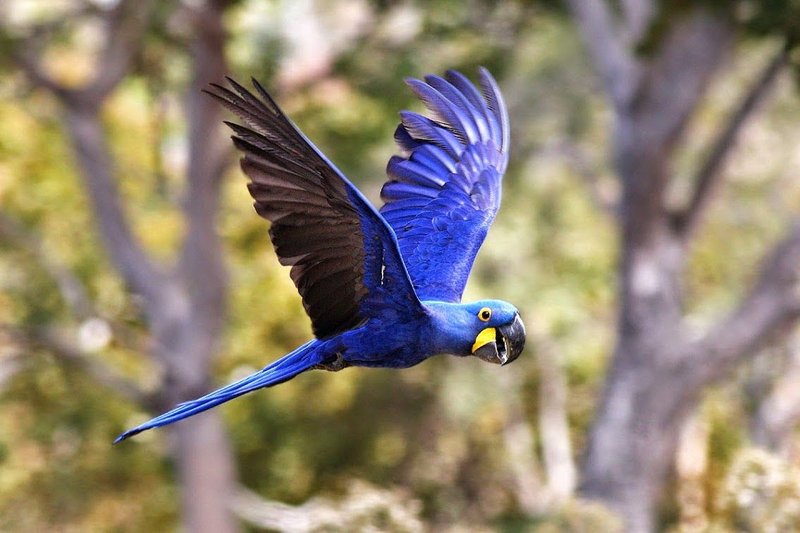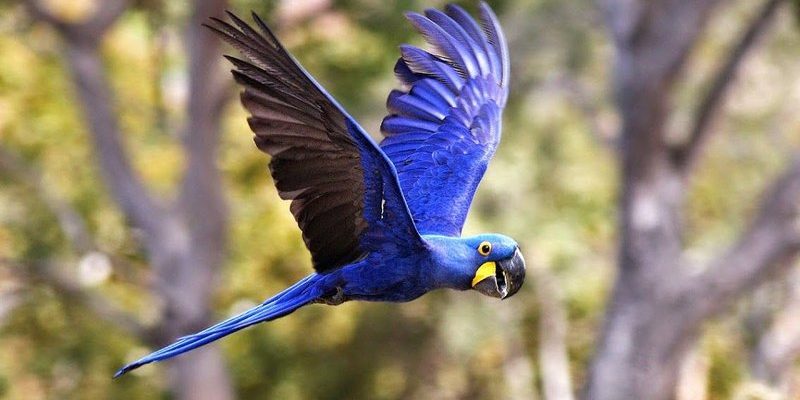
But how do you actually identify one? Honestly, it’s not just about their stunning color. The more you know about their characteristics, habitats, and behaviors, the better your chances of spotting these beauties in their natural surroundings. So, let’s grab a cup of coffee and dive into this colorful world of Hyacinth Macaws!
Physical Characteristics of Hyacinth Macaws
First off, let’s talk about what makes these birds stand out. The Hyacinth Macaw is the largest flying parrot species, which isn’t hard to believe when you see one up close. They can reach lengths of about 3 feet from beak to tail! But size isn’t everything. The vibrant cobalt blue feathers are the most eye-catching feature. These birds glisten in the sunlight, making them hard to miss.
Their large, curved beaks are another giveaway. Unlike many other parrot species, Hyacinth Macaws have a strong beak that allows them to crack open tough nuts like macadamias and coconuts. And let’s not forget their striking yellow patches on the face, around the eyes, and on the underside of their wings. These bright accents contrast beautifully with their deep blue feathers, making identification much easier.
So what else should you look for? Well, Hyacinth Macaws also have long, pointed tails that can look almost like a flag waving in the breeze. Their strong, powerful wings produce a distinctive flapping sound as they fly, which can give them away if you’re listening carefully. Just think of them as the “rock stars” of the bird world, with a look and sound that’s truly one of a kind.
Where to Find Hyacinth Macaws
You might be wondering where you can spot a Hyacinth Macaw in the wild. These birds primarily inhabit the tropical forests and palm swamps of South America, particularly in Brazil, Bolivia, and Paraguay. They love areas that provide plenty of tall trees for nesting and foraging. If you’re traveling to these regions, your best bet is to visit protected areas, national parks, or reserves where wildlife is conserved.
When you’re out exploring, listen for their distinctive squawking calls. They often chatter among themselves, especially when flying in groups. The calls can be loud, so if you hear something that sounds like a bunch of kids laughing, you might just be in Hyacinth Macaw territory.
Keep an eye out for their favorite feeding spots too. They tend to hang around places with abundant palm trees or nut-bearing trees, so if you see lots of activity around these plants, it’s a good sign. Bring your binoculars—you’ll want to get a closer look without startling them!
Behavioral Traits of Hyacinth Macaws
Now that you know what they look like and where to find them, let’s dive into their *behavior*. Hyacinth Macaws are social creatures. They often fly in pairs or small groups, chatting and interacting with one another. If you see a couple of these birds together, you’re likely witnessing a bonding moment, as they form strong monogamous relationships.
When they’re not soaring through the air, you’ll often find them hanging out on tree branches, preening their feathers or cracking nuts. They have an interesting way of using their beaks, sometimes hanging upside down to get the best angles on their food.
Their playful nature can also lead to some entertaining antics. You might see them engaging in playful squabbles with each other or showing off those impressive flying skills. Witnessing their playful side not only makes for a great experience but also helps you identify them more easily. Their confidence and curiosity can be quite charming!
Listening for Their Calls
If you’re trying to spot a Hyacinth Macaw, one of the best tricks is to listen for their vocalizations. They have a loud, distinctive call that can carry over long distances. Think of it as their way of saying, “Hey, I’m over here!”
These calls often sound like a series of squawks mixed with whistles, almost like a playful chorus. If you’re in an area where they live, pay attention to any sudden bursts of sound; it might just be a group of Hyacinth Macaws communicating with each other.
If you hear this call, keep your eyes peeled! They can be high up in the trees, so you might need to look carefully. Their bright colors will help them stand out against the green foliage, but only if the light hits them just right.
Conservation Status and Importance
As you’re on the lookout for Hyacinth Macaws, it’s important to remember that these beautiful birds are considered vulnerable due to habitat loss and illegal trapping for the pet trade. Their populations are declining, which is a real concern for conservationists.
Understanding their role in the ecosystem is vital. Hyacinth Macaws help maintain the health of their environments by dispersing seeds through their foraging habits. This means that spotting one is about more than just enjoying its beauty; it’s about appreciating its role in the natural world.
If you happen to see one in the wild, respect their space. Avoid disturbing their nests or feeding them. Instead, watch quietly and enjoy the incredible experience. By doing so, you’re supporting local conservation efforts that aim to protect these stunning creatures for future generations.
Final Tips for Spotting Hyacinth Macaws
Ready to hit the wild with your newfound knowledge about Hyacinth Macaws? Here are some quick tips to maximize your chances of spotting one:
- Pick the Right Time: Early morning or late afternoon are the best times. Macaws are often more active during these hours.
- Stay Quiet: Keep noise to a minimum. The quieter you are, the better chance you have of spotting them and hearing their calls.
- Use Binoculars: Bring a good pair of binoculars. This way, you can see them up close without disturbing them.
- Look for Their Food Sources: Find areas with plenty of palm trees or nut-bearing trees where they love to hang out.
- Be Patient: Wildlife watching requires patience. Sometimes you may have to wait a while to see them.
With these tips handy and a good sense of what to look for, you’re well-equipped for your adventure in the wild. Spotting a Hyacinth Macaw can be a magical experience, and it’s even better when you’re prepared. Enjoy the journey, and take a moment to appreciate these incredible birds in their natural habitat.
By learning how to identify Hyacinth Macaws, you’re not just preparing yourself for an amazing wildlife experience; you’re also connecting with nature in a meaningful way. There’s nothing quite like watching these majestic creatures in the wild—each sighting becomes a treasured memory. So get out there, and happy birdwatching!

